Solved Microeconomics Assignment: MPA603, Semester 2, 2018 Analysis
VerifiedAdded on 2023/06/05
|9
|1265
|258
Homework Assignment
AI Summary
This document provides solutions to a microeconomics assignment (MPA603, Semester 2, 2018). The solutions cover topics such as externalities, diminishing returns, market equilibrium, cost analysis, and firm behavior under perfect competition. Specific questions address the impact of pollution on social efficiency, optimal resource allocation in a village, the effects of changing input prices on market demand, production functions, and the long-run equilibrium of firms. The assignment uses graphs and tables to illustrate key economic concepts and principles. Desklib offers similar solved assignments and past papers to help students excel.
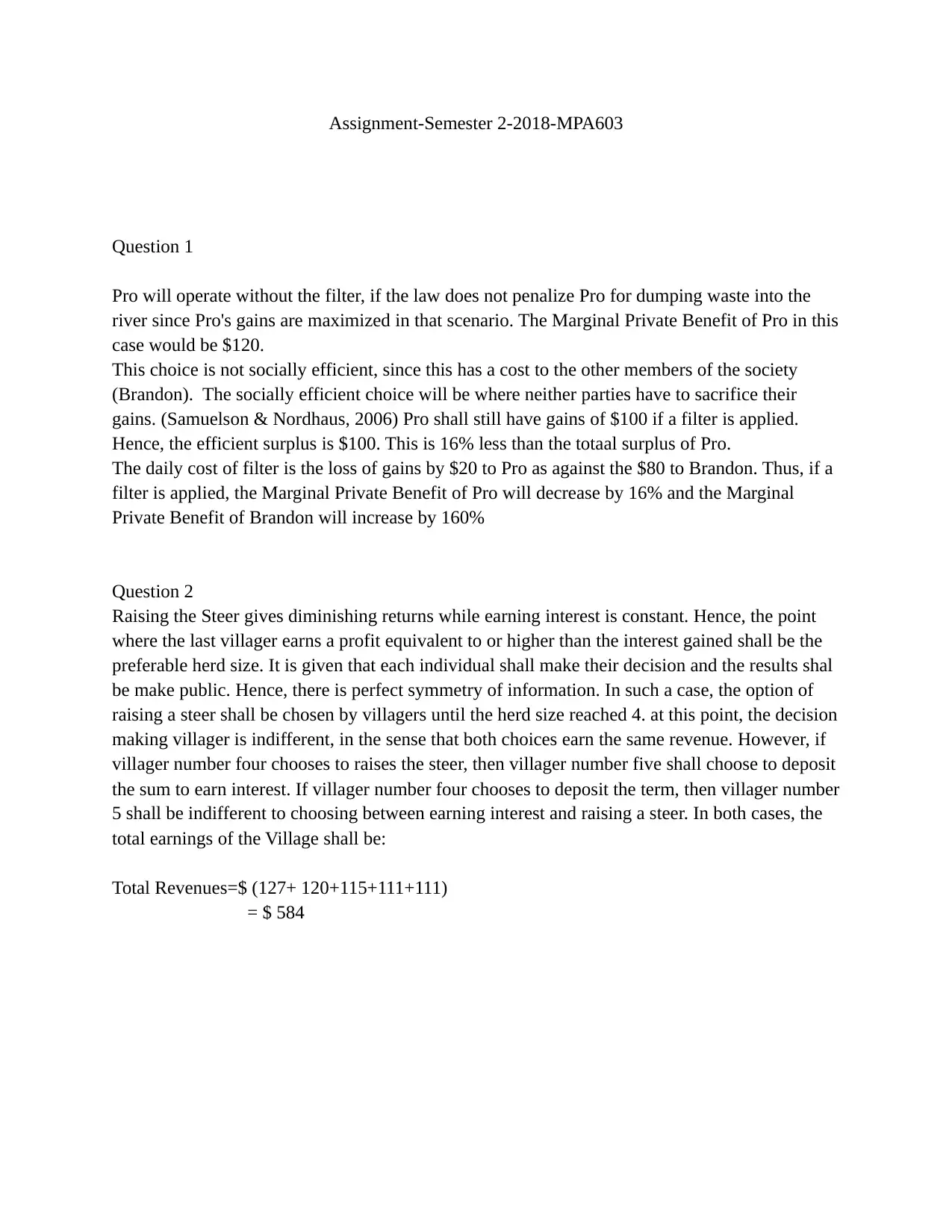
Assignment-Semester 2-2018-MPA603
Question 1
Pro will operate without the filter, if the law does not penalize Pro for dumping waste into the
river since Pro's gains are maximized in that scenario. The Marginal Private Benefit of Pro in this
case would be $120.
This choice is not socially efficient, since this has a cost to the other members of the society
(Brandon). The socially efficient choice will be where neither parties have to sacrifice their
gains. (Samuelson & Nordhaus, 2006) Pro shall still have gains of $100 if a filter is applied.
Hence, the efficient surplus is $100. This is 16% less than the totaal surplus of Pro.
The daily cost of filter is the loss of gains by $20 to Pro as against the $80 to Brandon. Thus, if a
filter is applied, the Marginal Private Benefit of Pro will decrease by 16% and the Marginal
Private Benefit of Brandon will increase by 160%
Question 2
Raising the Steer gives diminishing returns while earning interest is constant. Hence, the point
where the last villager earns a profit equivalent to or higher than the interest gained shall be the
preferable herd size. It is given that each individual shall make their decision and the results shal
be make public. Hence, there is perfect symmetry of information. In such a case, the option of
raising a steer shall be chosen by villagers until the herd size reached 4. at this point, the decision
making villager is indifferent, in the sense that both choices earn the same revenue. However, if
villager number four chooses to raises the steer, then villager number five shall choose to deposit
the sum to earn interest. If villager number four chooses to deposit the term, then villager number
5 shall be indifferent to choosing between earning interest and raising a steer. In both cases, the
total earnings of the Village shall be:
Total Revenues=$ (127+ 120+115+111+111)
= $ 584
Question 1
Pro will operate without the filter, if the law does not penalize Pro for dumping waste into the
river since Pro's gains are maximized in that scenario. The Marginal Private Benefit of Pro in this
case would be $120.
This choice is not socially efficient, since this has a cost to the other members of the society
(Brandon). The socially efficient choice will be where neither parties have to sacrifice their
gains. (Samuelson & Nordhaus, 2006) Pro shall still have gains of $100 if a filter is applied.
Hence, the efficient surplus is $100. This is 16% less than the totaal surplus of Pro.
The daily cost of filter is the loss of gains by $20 to Pro as against the $80 to Brandon. Thus, if a
filter is applied, the Marginal Private Benefit of Pro will decrease by 16% and the Marginal
Private Benefit of Brandon will increase by 160%
Question 2
Raising the Steer gives diminishing returns while earning interest is constant. Hence, the point
where the last villager earns a profit equivalent to or higher than the interest gained shall be the
preferable herd size. It is given that each individual shall make their decision and the results shal
be make public. Hence, there is perfect symmetry of information. In such a case, the option of
raising a steer shall be chosen by villagers until the herd size reached 4. at this point, the decision
making villager is indifferent, in the sense that both choices earn the same revenue. However, if
villager number four chooses to raises the steer, then villager number five shall choose to deposit
the sum to earn interest. If villager number four chooses to deposit the term, then villager number
5 shall be indifferent to choosing between earning interest and raising a steer. In both cases, the
total earnings of the Village shall be:
Total Revenues=$ (127+ 120+115+111+111)
= $ 584
Paraphrase This Document
Need a fresh take? Get an instant paraphrase of this document with our AI Paraphraser
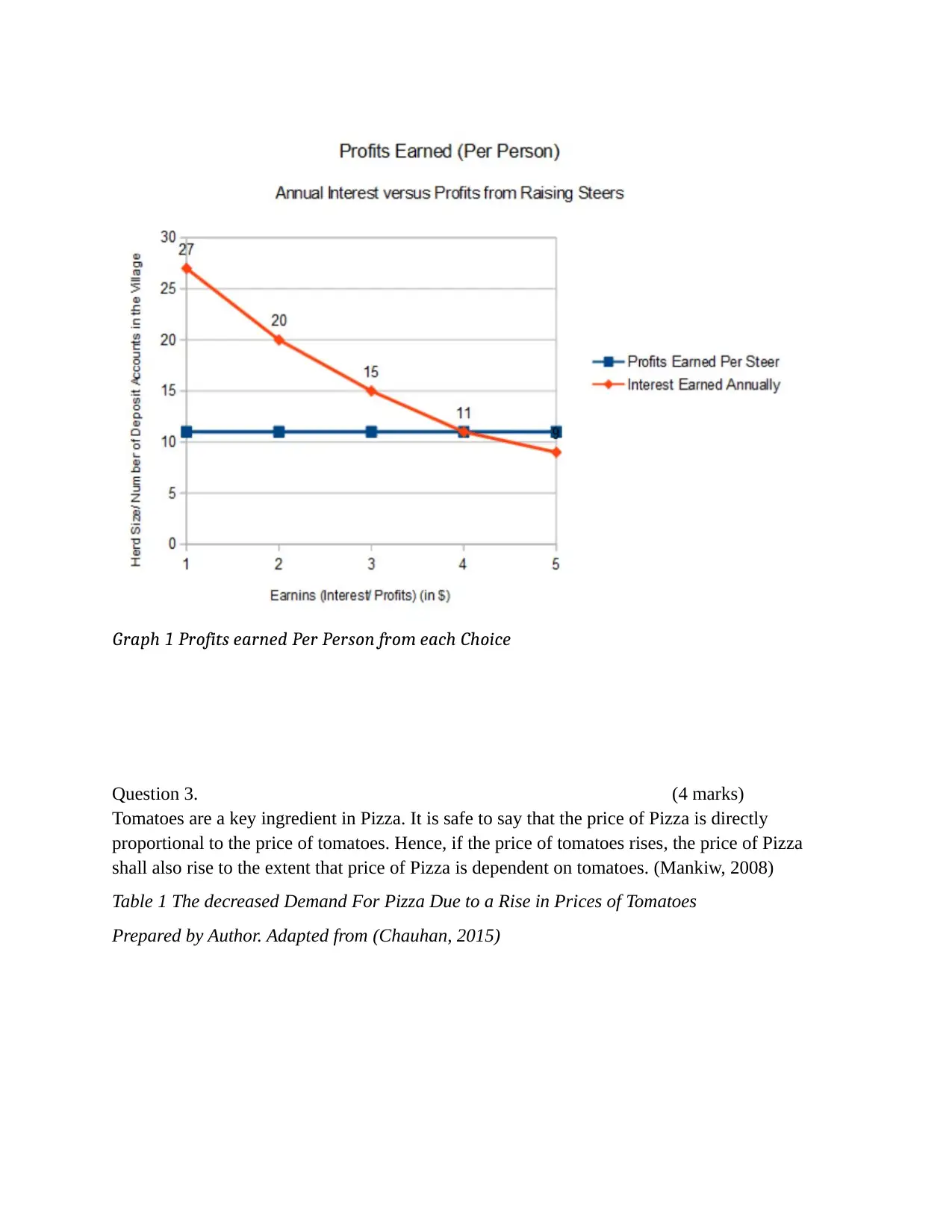
Question 3. (4 marks)
Tomatoes are a key ingredient in Pizza. It is safe to say that the price of Pizza is directly
proportional to the price of tomatoes. Hence, if the price of tomatoes rises, the price of Pizza
shall also rise to the extent that price of Pizza is dependent on tomatoes. (Mankiw, 2008)
Table 1 The decreased Demand For Pizza Due to a Rise in Prices of Tomatoes
Prepared by Author. Adapted from (Chauhan, 2015)
Graph 1 Profits earned Per Person from each Choice
Tomatoes are a key ingredient in Pizza. It is safe to say that the price of Pizza is directly
proportional to the price of tomatoes. Hence, if the price of tomatoes rises, the price of Pizza
shall also rise to the extent that price of Pizza is dependent on tomatoes. (Mankiw, 2008)
Table 1 The decreased Demand For Pizza Due to a Rise in Prices of Tomatoes
Prepared by Author. Adapted from (Chauhan, 2015)
Graph 1 Profits earned Per Person from each Choice
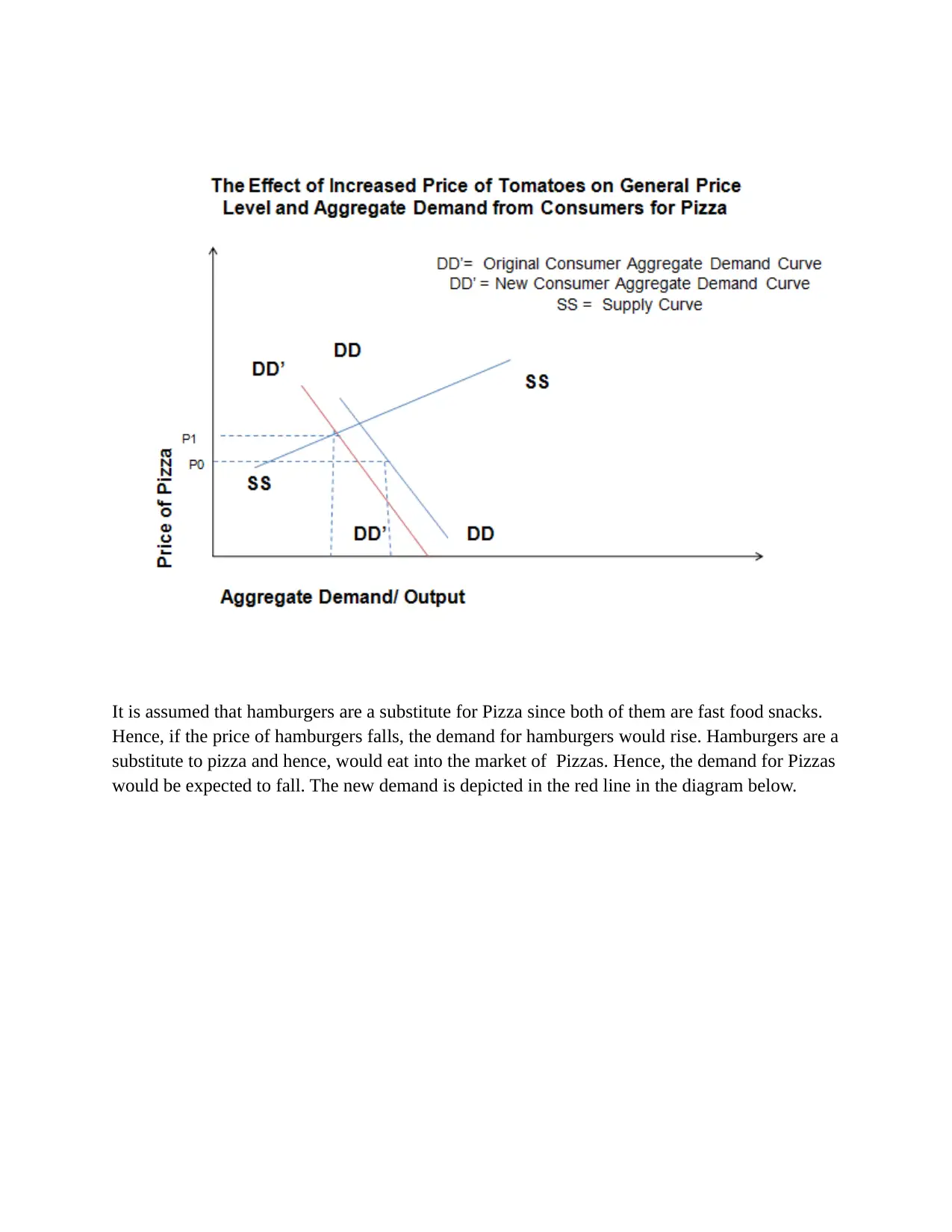
It is assumed that hamburgers are a substitute for Pizza since both of them are fast food snacks.
Hence, if the price of hamburgers falls, the demand for hamburgers would rise. Hamburgers are a
substitute to pizza and hence, would eat into the market of Pizzas. Hence, the demand for Pizzas
would be expected to fall. The new demand is depicted in the red line in the diagram below.
Hence, if the price of hamburgers falls, the demand for hamburgers would rise. Hamburgers are a
substitute to pizza and hence, would eat into the market of Pizzas. Hence, the demand for Pizzas
would be expected to fall. The new demand is depicted in the red line in the diagram below.
⊘ This is a preview!⊘
Do you want full access?
Subscribe today to unlock all pages.

Trusted by 1+ million students worldwide
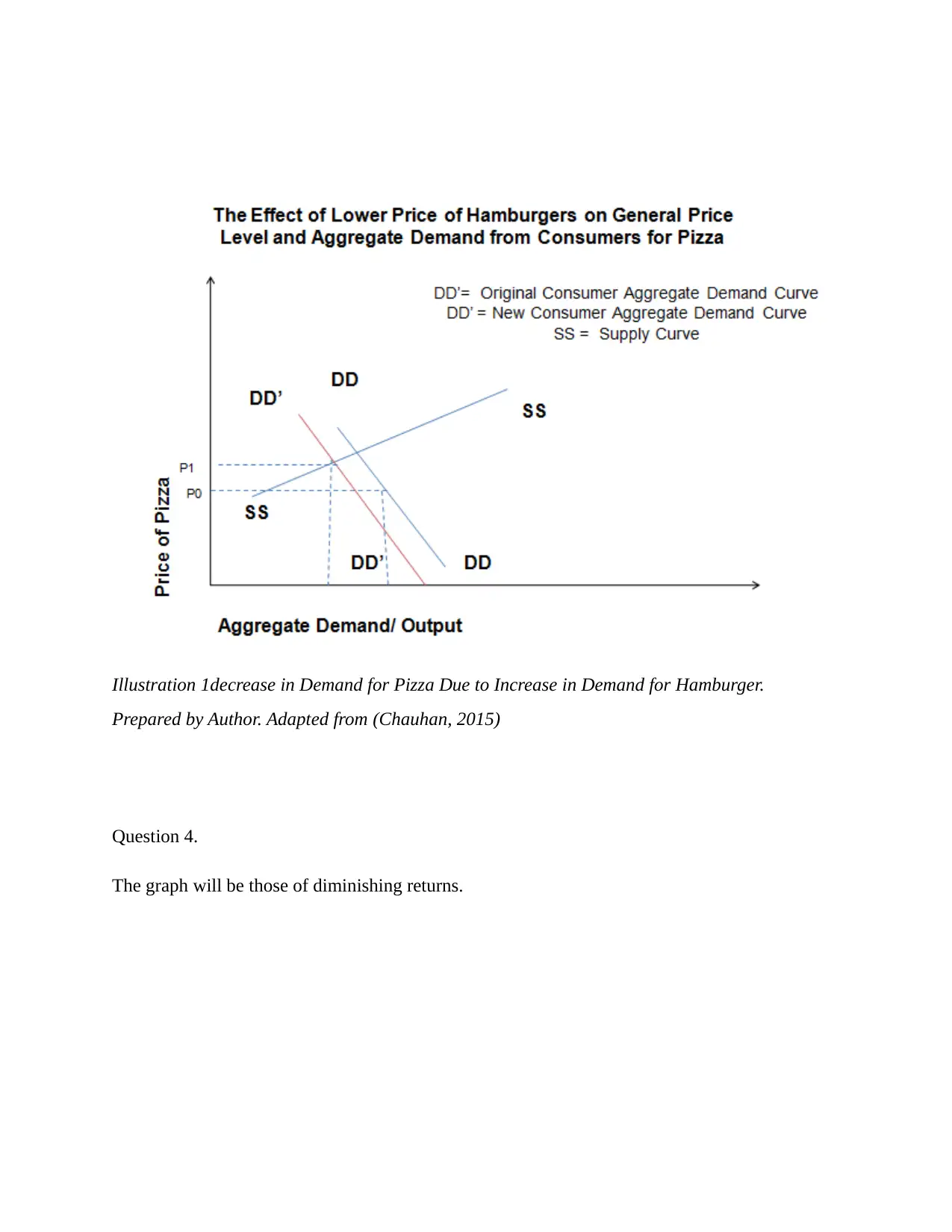
Illustration 1decrease in Demand for Pizza Due to Increase in Demand for Hamburger.
Prepared by Author. Adapted from (Chauhan, 2015)
Question 4.
The graph will be those of diminishing returns.
Prepared by Author. Adapted from (Chauhan, 2015)
Question 4.
The graph will be those of diminishing returns.
Paraphrase This Document
Need a fresh take? Get an instant paraphrase of this document with our AI Paraphraser
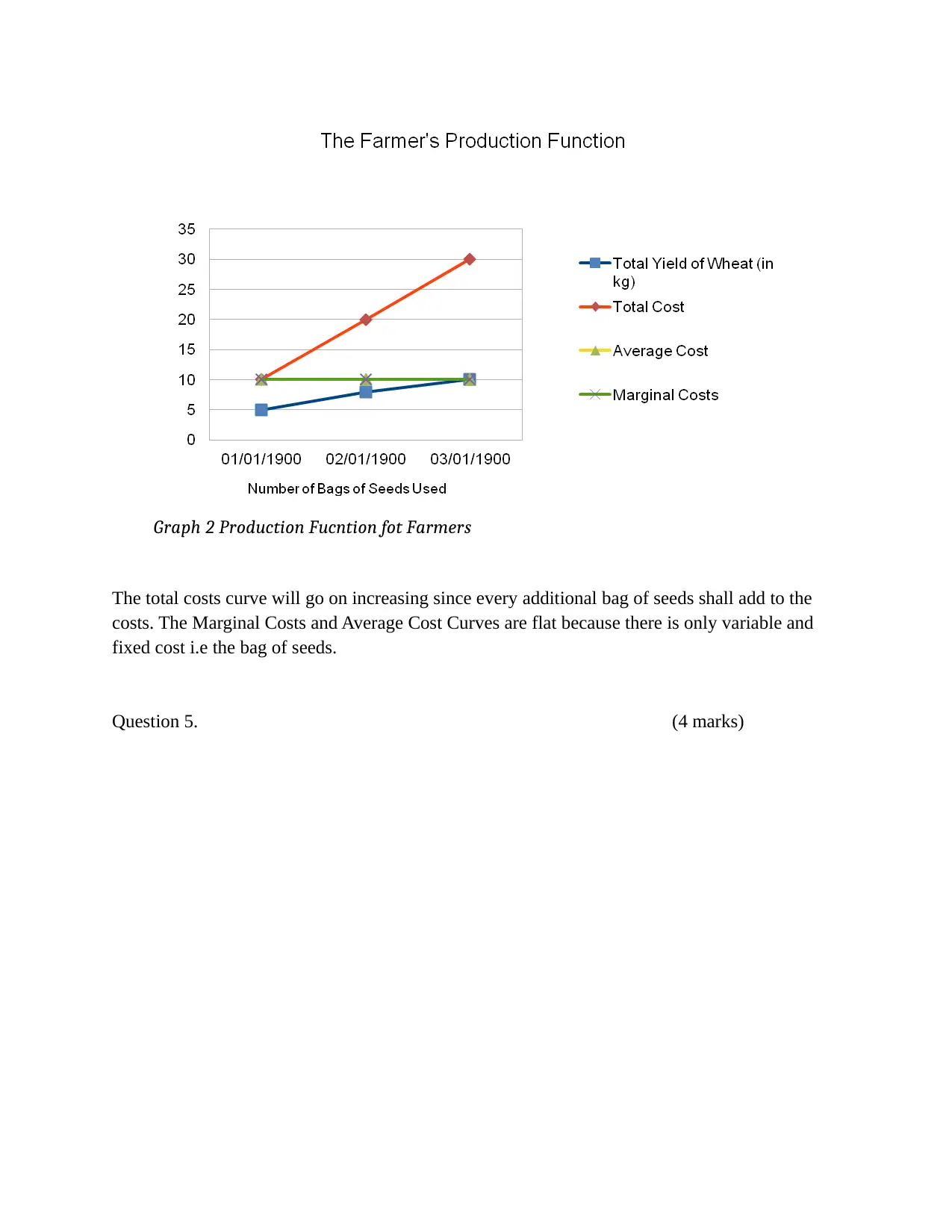
The total costs curve will go on increasing since every additional bag of seeds shall add to the
costs. The Marginal Costs and Average Cost Curves are flat because there is only variable and
fixed cost i.e the bag of seeds.
Question 5. (4 marks)
Graph 2 Production Fucntion fot Farmers
costs. The Marginal Costs and Average Cost Curves are flat because there is only variable and
fixed cost i.e the bag of seeds.
Question 5. (4 marks)
Graph 2 Production Fucntion fot Farmers
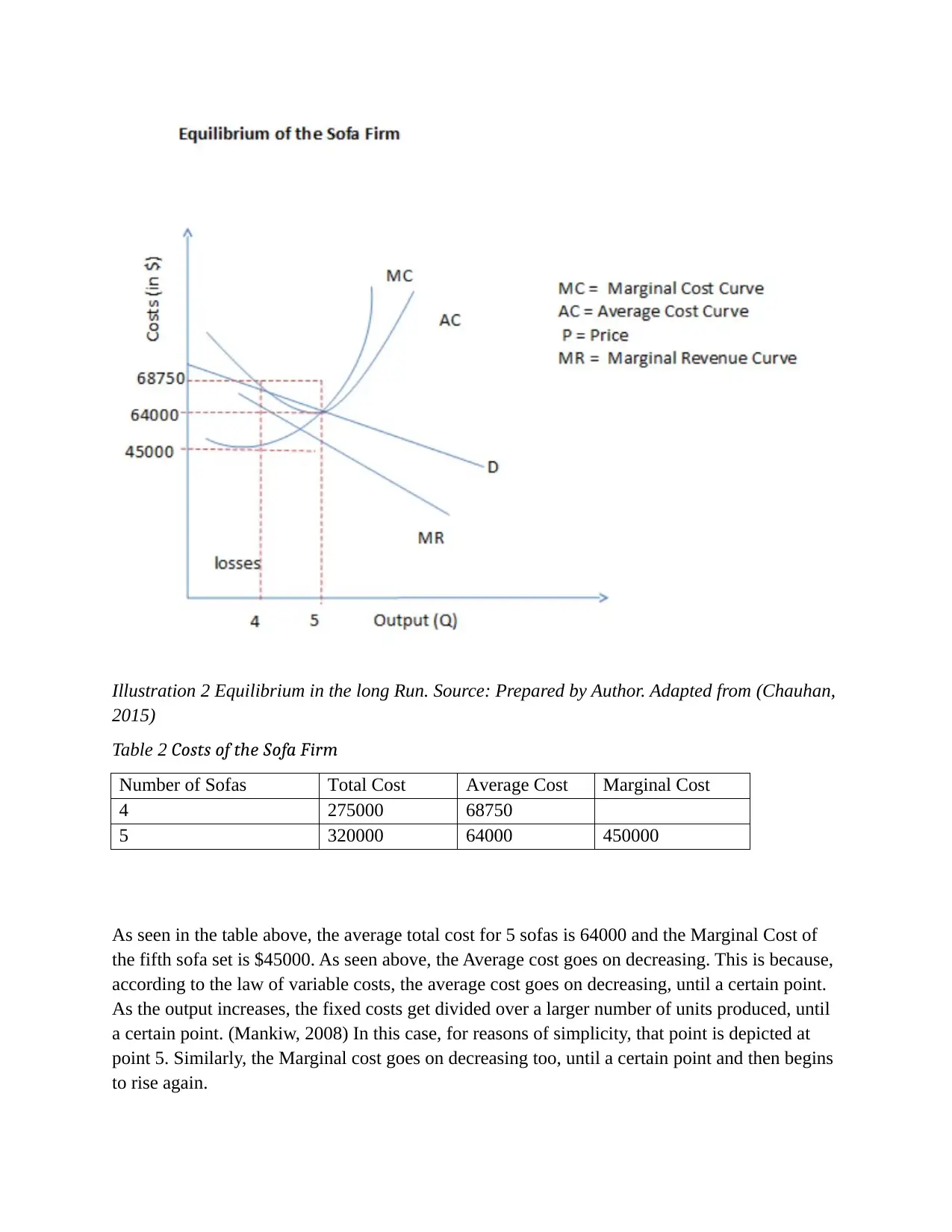
Illustration 2 Equilibrium in the long Run. Source: Prepared by Author. Adapted from (Chauhan,
2015)
Table 2 Costs of the Sofa Firm
Number of Sofas Total Cost Average Cost Marginal Cost
4 275000 68750
5 320000 64000 450000
As seen in the table above, the average total cost for 5 sofas is 64000 and the Marginal Cost of
the fifth sofa set is $45000. As seen above, the Average cost goes on decreasing. This is because,
according to the law of variable costs, the average cost goes on decreasing, until a certain point.
As the output increases, the fixed costs get divided over a larger number of units produced, until
a certain point. (Mankiw, 2008) In this case, for reasons of simplicity, that point is depicted at
point 5. Similarly, the Marginal cost goes on decreasing too, until a certain point and then begins
to rise again.
2015)
Table 2 Costs of the Sofa Firm
Number of Sofas Total Cost Average Cost Marginal Cost
4 275000 68750
5 320000 64000 450000
As seen in the table above, the average total cost for 5 sofas is 64000 and the Marginal Cost of
the fifth sofa set is $45000. As seen above, the Average cost goes on decreasing. This is because,
according to the law of variable costs, the average cost goes on decreasing, until a certain point.
As the output increases, the fixed costs get divided over a larger number of units produced, until
a certain point. (Mankiw, 2008) In this case, for reasons of simplicity, that point is depicted at
point 5. Similarly, the Marginal cost goes on decreasing too, until a certain point and then begins
to rise again.
⊘ This is a preview!⊘
Do you want full access?
Subscribe today to unlock all pages.

Trusted by 1+ million students worldwide
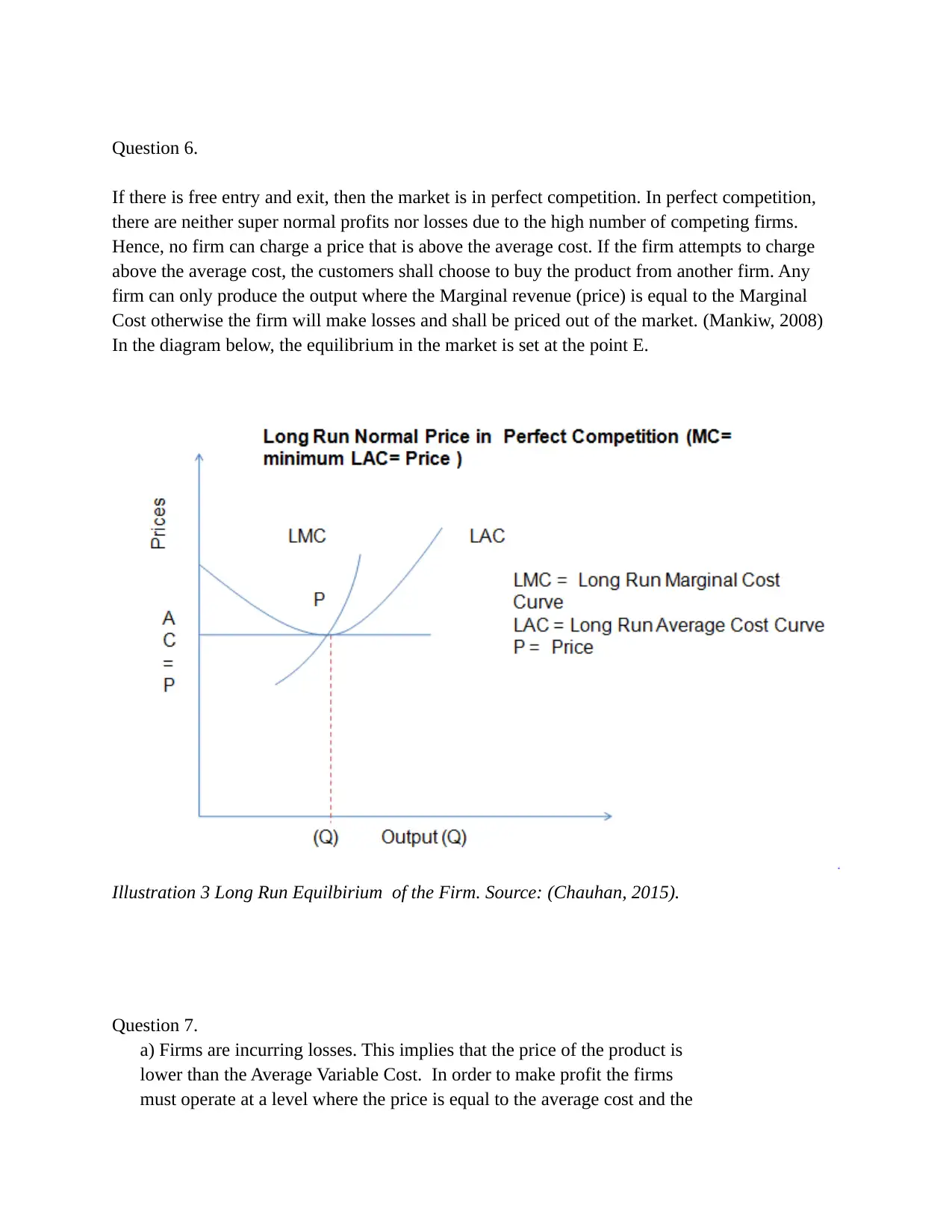
Question 6.
If there is free entry and exit, then the market is in perfect competition. In perfect competition,
there are neither super normal profits nor losses due to the high number of competing firms.
Hence, no firm can charge a price that is above the average cost. If the firm attempts to charge
above the average cost, the customers shall choose to buy the product from another firm. Any
firm can only produce the output where the Marginal revenue (price) is equal to the Marginal
Cost otherwise the firm will make losses and shall be priced out of the market. (Mankiw, 2008)
In the diagram below, the equilibrium in the market is set at the point E.
Illustration 3 Long Run Equilbirium of the Firm. Source: (Chauhan, 2015).
Question 7.
a) Firms are incurring losses. This implies that the price of the product is
lower than the Average Variable Cost. In order to make profit the firms
must operate at a level where the price is equal to the average cost and the
If there is free entry and exit, then the market is in perfect competition. In perfect competition,
there are neither super normal profits nor losses due to the high number of competing firms.
Hence, no firm can charge a price that is above the average cost. If the firm attempts to charge
above the average cost, the customers shall choose to buy the product from another firm. Any
firm can only produce the output where the Marginal revenue (price) is equal to the Marginal
Cost otherwise the firm will make losses and shall be priced out of the market. (Mankiw, 2008)
In the diagram below, the equilibrium in the market is set at the point E.
Illustration 3 Long Run Equilbirium of the Firm. Source: (Chauhan, 2015).
Question 7.
a) Firms are incurring losses. This implies that the price of the product is
lower than the Average Variable Cost. In order to make profit the firms
must operate at a level where the price is equal to the average cost and the
Paraphrase This Document
Need a fresh take? Get an instant paraphrase of this document with our AI Paraphraser
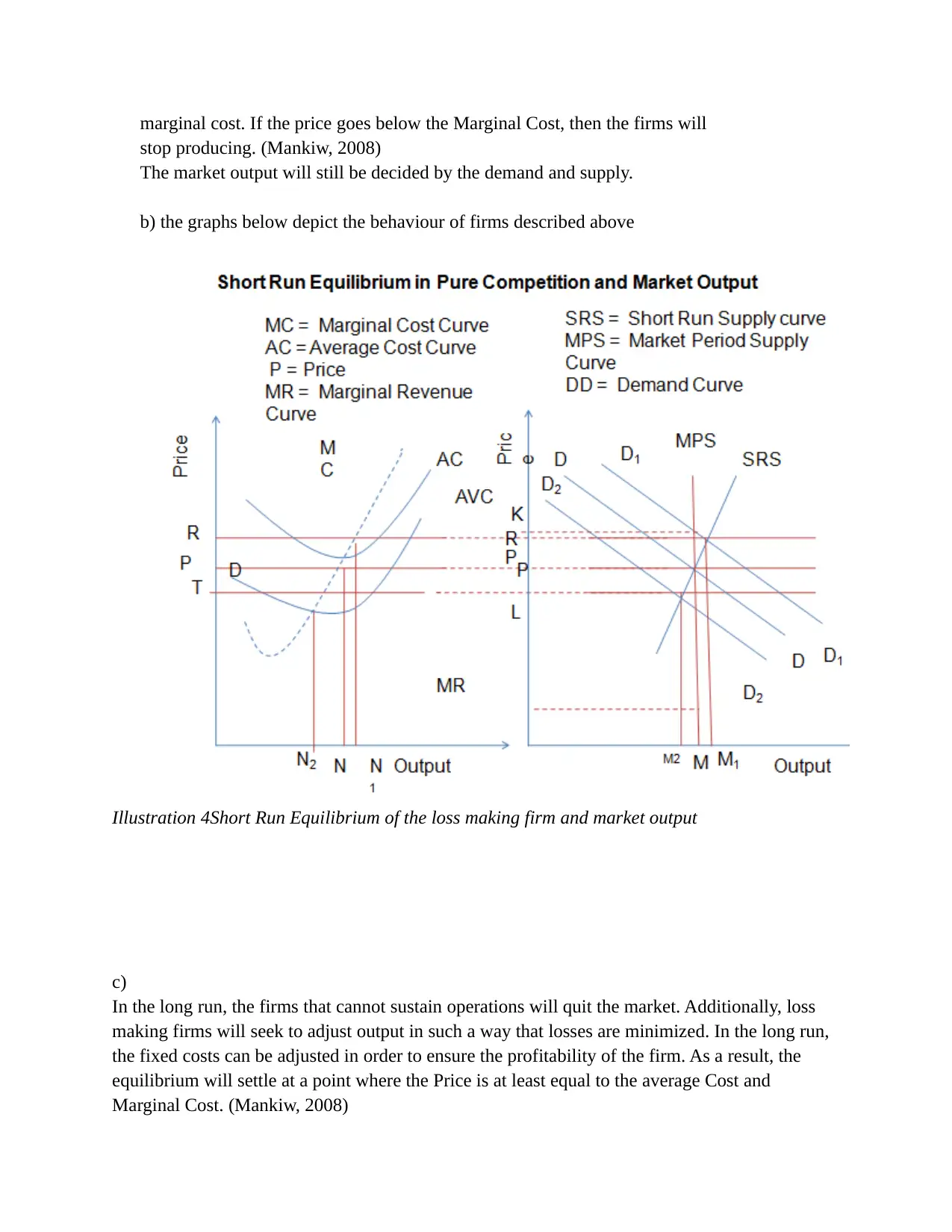
marginal cost. If the price goes below the Marginal Cost, then the firms will
stop producing. (Mankiw, 2008)
The market output will still be decided by the demand and supply.
b) the graphs below depict the behaviour of firms described above
Illustration 4Short Run Equilibrium of the loss making firm and market output
c)
In the long run, the firms that cannot sustain operations will quit the market. Additionally, loss
making firms will seek to adjust output in such a way that losses are minimized. In the long run,
the fixed costs can be adjusted in order to ensure the profitability of the firm. As a result, the
equilibrium will settle at a point where the Price is at least equal to the average Cost and
Marginal Cost. (Mankiw, 2008)
stop producing. (Mankiw, 2008)
The market output will still be decided by the demand and supply.
b) the graphs below depict the behaviour of firms described above
Illustration 4Short Run Equilibrium of the loss making firm and market output
c)
In the long run, the firms that cannot sustain operations will quit the market. Additionally, loss
making firms will seek to adjust output in such a way that losses are minimized. In the long run,
the fixed costs can be adjusted in order to ensure the profitability of the firm. As a result, the
equilibrium will settle at a point where the Price is at least equal to the average Cost and
Marginal Cost. (Mankiw, 2008)

The market output may become lower.
Illustration 5 Equilibrium in the long Run. Source: Prepared by Author. Adapted from (Chauhan,
2015)
Bibliography
Chauhan, S. (2015). MICROECONOMICS: AN ADVANCED TREATISE. New Delhi: PHI Learning
Private Limited.
Mankiw, G. (2008). Principles of Microeconomics (5th ed.). Mason Ohio: Cengage Learning.
Samuelson, P. A., & Nordhaus, W. D. (2006). Economics (18th International Edition). New
delhi: Tata McGraw Hill.
Illustration 5 Equilibrium in the long Run. Source: Prepared by Author. Adapted from (Chauhan,
2015)
Bibliography
Chauhan, S. (2015). MICROECONOMICS: AN ADVANCED TREATISE. New Delhi: PHI Learning
Private Limited.
Mankiw, G. (2008). Principles of Microeconomics (5th ed.). Mason Ohio: Cengage Learning.
Samuelson, P. A., & Nordhaus, W. D. (2006). Economics (18th International Edition). New
delhi: Tata McGraw Hill.
⊘ This is a preview!⊘
Do you want full access?
Subscribe today to unlock all pages.

Trusted by 1+ million students worldwide
1 out of 9
Your All-in-One AI-Powered Toolkit for Academic Success.
+13062052269
info@desklib.com
Available 24*7 on WhatsApp / Email
![[object Object]](/_next/static/media/star-bottom.7253800d.svg)
Unlock your academic potential
Copyright © 2020–2025 A2Z Services. All Rights Reserved. Developed and managed by ZUCOL.
